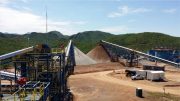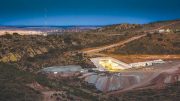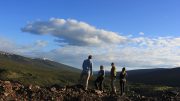Americas Silver (TSX: USA; NYSE-AM: USAS), a producer with mines in the U.S. and Mexico, is merging with Pershing Gold (TSX: PGLC; NASDAQ: PGLC) in an all-share deal.
Pershing’s primary asset is its Relief Canyon project in Nevada, which is expected to have average life-of-mine production of 91,000 oz. gold a year (7 million oz. silver-equivalent) over a 5.6-year mine life, with cash costs of US$769 per oz. and all-in sustaining costs of US$801 per oz. gold.
The project, 153 km northeast of Reno, consists of three historic open-pit mines and a fully permitted, heap-leach processing facility. Relief Canyon could start commercial production in 2020, after a six- to nine-month construction period beginning next year. A feasibility study completed in May estimates an initial US$28.2-million capital expense, a US$133-million post-tax, net present value at a 5% discount rate, and 87% post-tax internal rate of return (IRR).
“It’s no secret that we’ve wanted the company to have more precious metal exposure and that we love Nevada,” Darren Blasutti, Americas Silver’s president and CEO, told analysts and investors on a conference call. “This is a project we’ve been looking at for the last three or four years …. it’s shovel ready from both a technical perspective and a permitting perspective. It’s brownfield and has great infrastructure, and we believe we will find mine-life extensions … we see more ounces in the pit and more ounces on the property.”
Relief Canyon’s resource is geologically open at depth and to the east, west and south, and there is potential for discoveries on Pershing’s broader 117.4 sq. km land package
“Only 20% of the project has been explored to date,” Blasutti said. “There are more ounces to come than what we see in the feasibility study.”
Under the merger, Pershing shareholders will receive 0.715 share of Americas Silver for each Pershing share they own. Based on the closing price of Americas Silver on the NYSE American Stock Exchange on Sept. 28, the deal implies a value of US$1.69 per Pershing share, which is a 39% premium to Pershing’s closing price on Nasdaq, and a 39% premium based on the volume-weighted average prices of Americas Silver and Pershing for the 10-day period ended Sept. 28.
Shareholders of Americas Silver and Pershing will own 64% and 36%, respectively, on an undiluted basis.
For its part, Americas Silver sees the merger as an opportunity to get a permitted project into production quickly in one of the best jurisdictions on the planet. It also suits its goal of building a profitable and low-cost precious metal company in the Americas by building and operating low-risk, low-capital, high-return projects.
Pershing Gold is permitted to resume mining at Relief Canyon under the existing plan of operations and has all the state and federal permits needed to start the phase-one mining and heap-leach processing operation. The company has already submitted permit applications for phase two, which allows for more mining below the water table.

A drill at Pershing Gold’s Relief Canyon gold project in Nevada. Credit: Pershing Gold.
“At Americas Silver, we don’t do these things lightly,” Blasutti said of the proposed business combination. “We’ve thought very hard. We’ve looked at probably over 75 assets in the last four or five years, and … we think this is going to be transformational for the company.
“When you take not only the IRR of the project, but even when you include the acquisition costs, you’re talking about 15–20% on an IRR basis at spot prices,” he said. “You don’t see that very often in the mining industry.”
For Pershing Gold, aligning with Americas Silver will provide a path to developing Relief Canyon with the increased financial and operating capabilities of the combined company, and Americas Silver’s experience in quickly and cheaply developing its San Rafael silver-zinc-lead underground mine in Sinaloa, Mexico.
Americas Silver built San Rafael for US$17 million — 25% lower than the initial prefeasibility study estimate. The mine started commercial production in December 2017.
San Rafael is part of the Cosala complex, 240 km from Mazatlan, along the western edge of the Sierra Madre Occidental, and includes the Cosala (Los Braceros) process plant, the El Cajon deposit, which adjoins San Rafael to the southwest, Nuestra Senora, an active mine 12 km southeast of San Rafael, and the Zone 120 deposit, which has silver-copper-gold mineralization similar to the nearby El Cajon mine.
Mineralization at Zone 120 has been found over an area greater than 500 metres long, 300 metres wide and 550 metres deep, and Americas Silver expects to finish a resource estimate and an internal mine plan soon.
Pershing Gold shareholders also gain a second asset — Americas’ Galena complex in Idaho’s Silver Valley.
Galena has an operating history dating to 1885, and between 1953 and 2015 produced more than 250 million oz. silver, along with by-product lead and copper.
The property hosts the operating Galena mine with two shafts, the Galena processing plant, the idle Coeur mine, with one shaft, and the Coeur processing facility, which is on care and maintenance.

Regrind mills at Americas Silver’s San Rafael silver-lead-zinc mine in Mexico. Credit: Americas Silver.
Americas Silver acquired Galena through its business combination with U.S. Silver & Gold Inc. in 2014 (when Americas Silver was known as Scorpio Mining), and since then has cut cash costs per ounce of silver more than 50%, by focusing on cost control and operating efficiencies.
The complex is located in the Coeur d’Alene mining district of Shoshone County.
Spokane, Wash., lies 121 km west and Missoula, Mon., 177 km east.
Blasutti said the transaction “will be well-endorsed by analysts and the market … as we increase our precious metals exposure and bring another project into the pipeline,” and noted that paying a nearly 40% premium was “well worth it.”
“The economics of the project are robust, with quick payback and a high IRR,” Blasutti said.
Pershing adds 7 million oz. silver equivalent a year, he added, and “establishes Americas Silver as a premium junior precious metal producer.
“For both companies this is a bit of diversification of our asset portfolios,” he said. “Over the years we have weighted the assets more to base metals than silver, because it’s very difficult to make money in the silver industry at US$14 silver, so we’ve turned our mines more into polymetallic mines than silver mines … [but our exposure to silver] is less than we like.”
Americas Silver expects to start construction at Relief Canyon in 2019 and reach commercial production in 2020, and Blasutti says the company will speak to banks, streaming and royalty companies to find the lowest cost of capital.
“We’ve already had a number of people contact us … who want to fund the [Relief Canyon] project — from banks to private equity firms,” he said, adding that the two companies “have a stronger financial position together.
“The optimal scenario would be to have a bank come in and do a project financing for the bulk of it,” he said. “The Pershing guys have had some discussions … but being a single-asset company, it was more difficult for them.”
In connection with the transaction, Pierre Lassonde and Trinity Capital Partners are providing Americas Silver with a $5.5-million, short-term, secured convertible loan, with interest payable at 1.25% per month.
The loan will help fund a US$4-million, short-term, secured first-lien convertible loan to address Pershing’s near-term working capital requirements, including permit advancements.
Meanwhile, Americas Silver expects to execute on San Rafael and achieve full production by year-end, which “will increase cash flow for 2019 and 2020, and increase silver production,” Blasutti said.
Zone 120 is also “an exciting development option for us … and we believe this project can be brought into production by 2020, if we want to.”





Be the first to comment on "Americas Silver and Pershing Gold to merge"